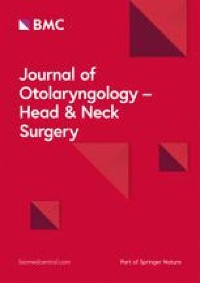|
Medicine RSS-Feeds by Alexandros G. Sfakianakis,Anapafseos 5 Agios Nikolaos 72100 Crete Greece,00302841026182,00306932607174,alsfakia@gmail.com
Πληροφορίες
Τρίτη 22 Μαρτίου 2022
ROBOTIC REPAIR OF ATRIAL SEPTAL DEFECT WITH PARTIAL PULMONARY VENOUS RETURN ANOMALY: OUR 5‐YEAR EXPERIENCE
The effectiveness of topical 1% lidocaine with systemic oral analgesics for ear pain with acute otitis media
|
Comparison of Video Head Impulse Test Findings in Individuals Aged between 20–39 and 40–60 Years
|
Bionic hearing in auditory neuropathy spectrum disorder: A systematic review
|
Pinna injuries management at tertiary care center
|
Otogenic Cerebral Venous Sinus Thrombosis: A Case Report and Literature Review
|
The Endonasal Endoscopic Approach to Different Sinonasal Fungal Balls
|
Injection laryngoplasty during transoral laser microsurgery for early glottic cancer: a randomized controlled trial
|
Evolution of midface microvascular reconstruction: three decades of experience from a single institution
|
Αρχειοθήκη ιστολογίου
-
►
2023
(366)
- ► Φεβρουαρίου (184)
- ► Ιανουαρίου (182)
-
▼
2022
(2814)
- ► Δεκεμβρίου (182)
- ► Σεπτεμβρίου (213)
-
▼
Μαρτίου
(309)
-
▼
Μαρ 22
(9)
- ROBOTIC REPAIR OF ATRIAL SEPTAL DEFECT WITH PARTIA...
- The effectiveness of topical 1% lidocaine with sys...
- Comparison of Video Head Impulse Test Findings in ...
- Bionic hearing in auditory neuropathy spectrum dis...
- Pinna injuries management at tertiary care center
- Otogenic Cerebral Venous Sinus Thrombosis: A Case ...
- The Endonasal Endoscopic Approach to Different Sin...
- Injection laryngoplasty during transoral laser mic...
- Evolution of midface microvascular reconstruction:...
-
▼
Μαρ 22
(9)
- ► Φεβρουαρίου (264)
- ► Ιανουαρίου (262)
-
►
2021
(3815)
- ► Δεκεμβρίου (229)
- ► Σεπτεμβρίου (276)
- ► Φεβρουαρίου (64)
-
►
2020
(5754)
- ► Δεκεμβρίου (401)
- ► Σεπτεμβρίου (365)
- ► Φεβρουαρίου (754)
- ► Ιανουαρίου (894)
-
►
2019
(146)
- ► Δεκεμβρίου (19)
- ► Σεπτεμβρίου (54)







